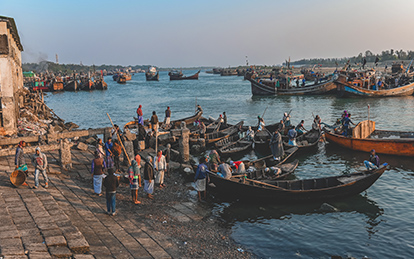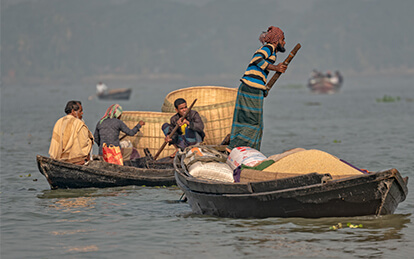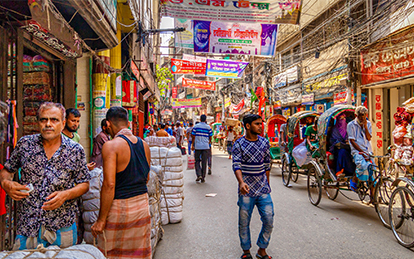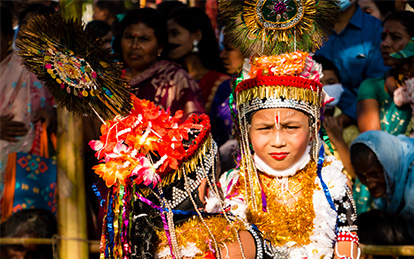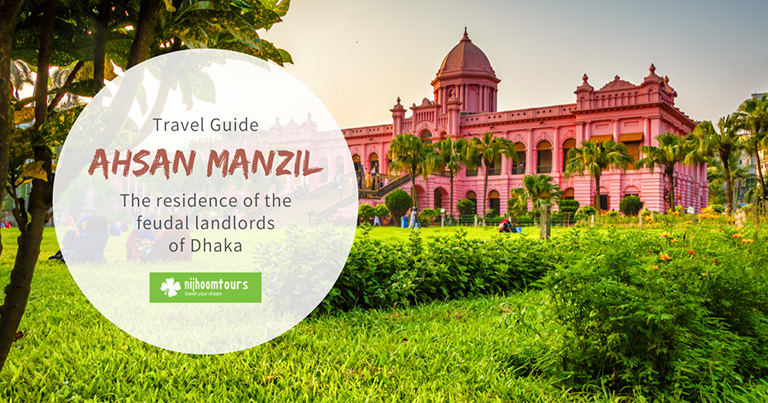
Photo, history, museum, visiting hours, off day, online ticket, ticket price, tips on visiting, frequently asked questions, and every other detail of Ahsan Manzil (Pink Palace), the grand palace of the feudal landlords of Dhaka located in Old Dhaka.
Ahsan Manzil, also known as the Pink Palace, is one of Dhaka city’s most popular tourist attractions. Located in Old Dhaka on the bank of the river Buriganga, this was the residence of the most influential family in Dhaka, who were the feudal landlords during British rule in the Indian Sub-Continent.
The Nawab family acquired a small property in the early 19th century and built this massive palace on that property over the next few generations, as their income flourished. The palace eventually declined with the end of British rule. Govt. of Bangladesh later acquired the property and opened it as a museum after renovation. Ahsan Manzil is a must visiting attraction for anyone visiting Bangladesh.
Table of Contents
- The History of Ahsan Manzil
- Ahsan Manzil Visiting Hours
- Ahsan Manzil Off Day
- Ahsan Manzil Ticket
- Ahsan Manzil Contact No
- Frequently Asked Questions
- Visiting Ahsan Manzil
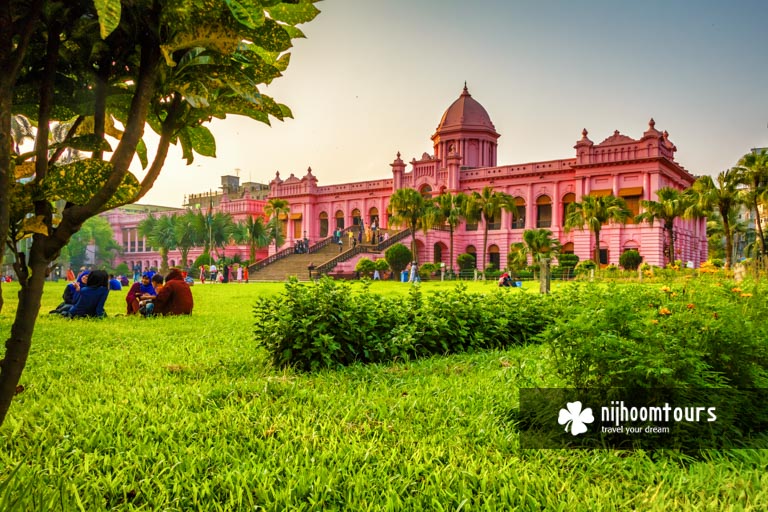
Ahsan manzil (Pink Palace) in Old Dhaka at present. ©Photo Credit: Raw Hasan.
The History of Ahsan Manzil
Ahsan Manzil served as the official residence of the Dhaka nawabs, the prominent aristocrats of the region. Throughout its history, the palace witnessed various phases, including renovations, expansions, and changes in ownership due to shifts in political power.
The Early Stage of the Property
In the Mughal period, there was a summer house of Sheikh Enayet Ullah, the landlord of Jamalpur Porgona (Barisal), in this place. Sheikh Enayet Ullah was a very charming person. He acquired a massive area in Kumartuli and included it in his summer house. Here he built a beautiful palace and named it “Rong Mahal”. He entertained here, keeping beautiful girls collecting from home and abroad, dressing them in gorgeous dresses and expensive ornaments.
There is a saying that the Faujdar of Dhaka (representative of the Mughal emperor) was attracted to one of the beautiful girls. He invited Sheikh Enayet Ullah to a party one night and killed him in a conspiracy when returning home. That girl also committed suicide in anger and sorrow. There was a one-doomed cemetery of Sheikh Enayet Ullah in the north-east corner of the palace yard, which was ruined at the beginning of the 20th century.
▲ Back to the Table of Contents
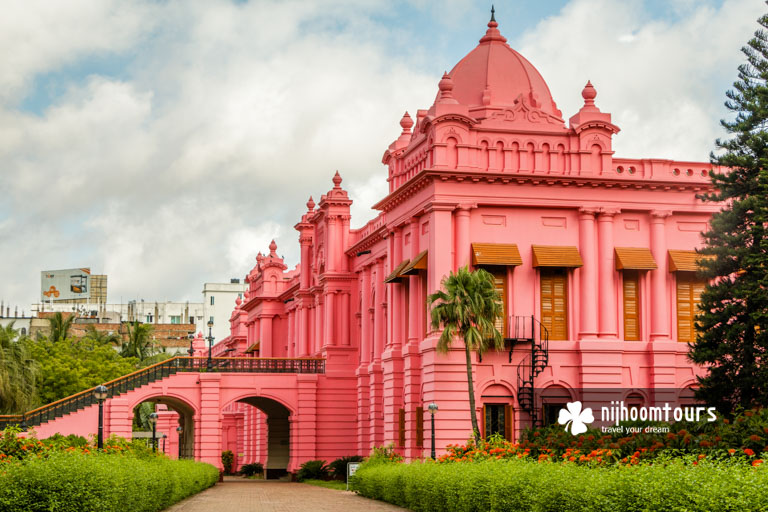
A side view of the Rong Mahal (Entertainment House). ©Photo Credit: Raw Hasan.
Acquiring the Property by the Nawab Family
In Nawab Alibardi Khan’s period around 1740 A.D., Sheikh Moti Ullah, the son of Sheikh Enayet Ullah, sold the property to the French traders. There was a French trading house beside this property. The trading house became wealthier after purchasing this property. At that time, french traders could do business here without paying any taxes by a decree from the emperor Awrangajeb.
The French became wealthy doing business here in competition with the English and the other European companies. They made a big palace and dug a pond for sweet water in the newly purchased property. The pond still exists in the compound of Ahsan Manzil, which was called “Les Jalla” at that time. In the English-French war, the French got defeated, and the English captured all their properties. On the 22nd June of 1757, the French left the trading house with a fleet of 35 boats from the river station of Buriganga in Kumartuli.
In 1785, the English transferred the property to a French tradesman named Mr. Champigni and retaken it in 1801. According to the Paris agreement of 1814, the French claimed all their left properties at Dhaka, and in 1827 the property was again returned to the French. For the increasing power of the English, the French were forced to leave the sub-continent. They decided to sell all their properties in Dhaka. So in 1830, the trading house of Kumartuli was purchased by the established landlord of Dhaka, Khwaja Alimullah.
▲ Back to the Table of Contents
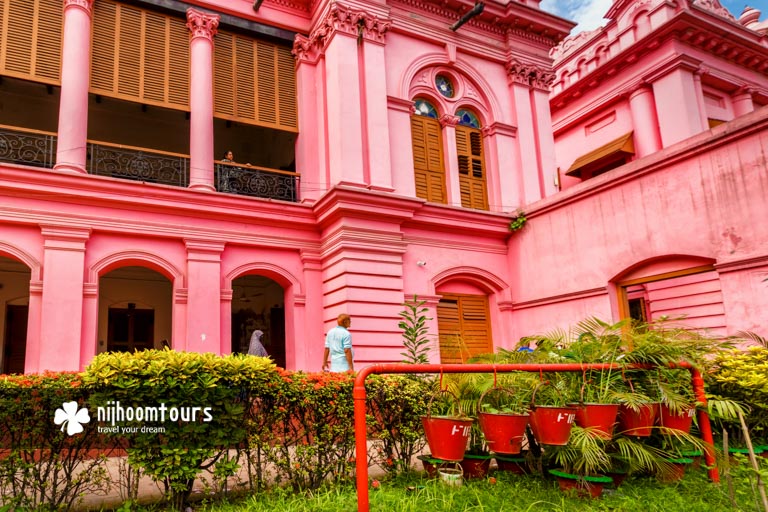
The Ondor Mahal (Residential House) of Pink Palace in Dhaka. ©Photo Credit: Raw Hasan.
The Founding of Ahsan Manzil
After some renovation work, the French trading house became the residence of Khwaja Alimullah. In his time, a stable and a family mosque was added to the compound. After his death, his son Khwaja Abdul Gani made a huge development to the property and named it “Ahsan Manzil” on his son Ahsan Ullah.
On the east side of the old building, he made a new building with a different design and also done great renovation work to the old building. Since then, the old building was called “Ondor Mahal” (The residential house), and the new building was called “Rong Mahal” (The entertainment house).
▲ Back to the Table of Contents
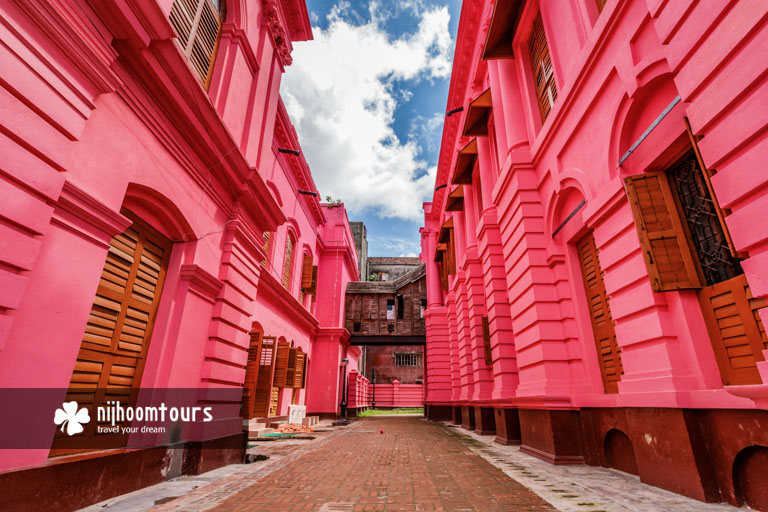
The gangway connecting the two buildings of Pink Palace. ©Photo Credit: Raw Hasan.
Restoration of Ahsan Manzil
On the evening of 7th April 1888, a great tornado hit Dhaka city, causing great damage. Ahsan Manzil was greatly damaged and abandoned. An English engineer from Kolkata arrived here to examine the palace. He gave the opinion that except for the “Rong Mahal”, all other parts of the palace have to be reconstructed.
So Khwaja Abdul Gani and his son Ahsanullah turned their full attention to reconstruct the palace. During that time, both buildings were reconstructed with a new design, made and supervised by the local engineer Gobinda Chandra Roy.
The old French building was reconstructed to a two-storied building keeping similarity to the Rong Mahal. A gangway was made with wood connecting the first floor of two buildings. The most beautiful thing made at this time was the doom, which made the palace so beautiful.
▲ Back to the Table of Contents
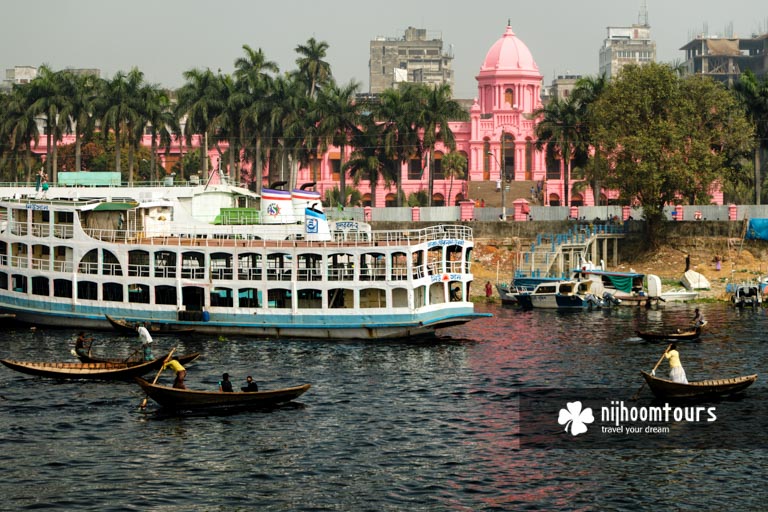
A river view of the Pink Palace. ©Photo Credit: Raw Hasan.
The Decline of Ahsan Manzil
After the death of Khwaja Ahsanullah in 1901, the glory of Ahsan Manzil was ended. His successors couldn’t continue the glory for the internal family quarrel. They rented different parts of the palace to tenants, who actually made it a slum. In 1952, govt. acquired the property and left under the supervision of the Dhaka Nawab court. In 1985, Dhaka National Museum acquired the property and made it a museum.
▲ Back to the Table of Contents
A Timeline of Ahsan Manzil
- Mughal Period: A small entertainment house of Sheikh Enayet Ullah, the feudal landlord of Jamalpur Pargana.
- 1740 AD: Became a trading house of the French.
- 1757 – 1785 AD: Became a property of the British.
- 1785 – 1801 AD: Became a property of a French tradesman called Mr. Champigni.
- 1801 – 1827 AD: Property of the British again.
- 1827 – 1830 AD: Went back to the French traders under the Paris agreement of 1814 AD with the British.
- 1830 AD: The French left the Indian Sub-Continent. Nawab Alimullah purchased the property and it became the residence of the landlords of Dhaka. A new building was built by his son Khwaja Addul Gani.
- 1888 AD: A great tornedo severely damaged Ahsan Manzil and Khwaja Abdul Gani reconstructed it. The original building was made two-stroyed and connected with the new building by a wooden gangway. The dome of the entertainment house was added.
- 1952 AD: The feudal land ownership system was abolished. The property went under the control of the government of then Pakistan.
- 1985 AD: Bangladesh government renovated it and opened it as a museum.
▲ Back to the Table of Contents
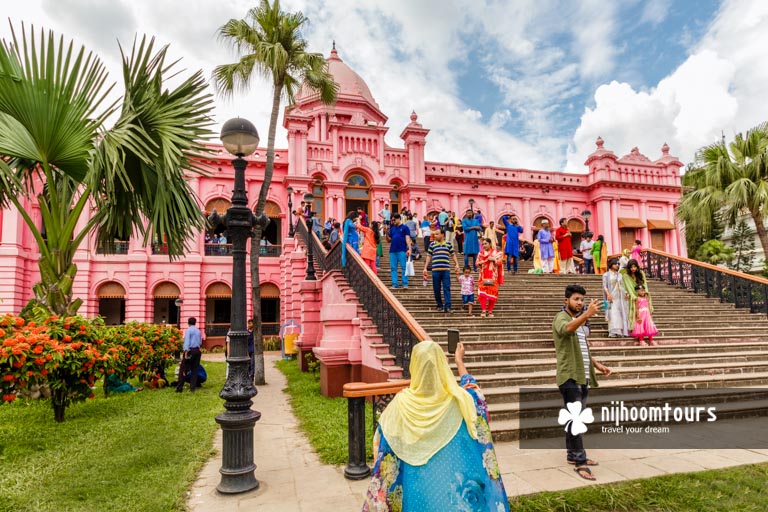
A front view of the Rong Mahal (The entertainment house). ©Photo Credit: Raw Hasan.
Ahsan Manzil Visiting Hours
Ahsan Manzil Visiting Hours During Summer (April – September)
- Saturday – Wednesday: 10.30 AM – 05.30 PM
- Friday: 03.00 PM – 07.30 PM
Ahsan Manzil Visiting Hours During Winter (October – March)
- Saturday – Wednesday: 09.30 AM – 04.30 PM
- Friday: 02.30 PM – 07.30 PM
Ahsan Manzil Visiting Hours During Ramadan
- Saturday – Wednesday: 09.30 AM – 03.00 PM
▲ Back to the Table of Contents
Ahsan Manzil Off Day
Ahsan Manzil has one weekly off day throughout the year except for the holy month of Ramadan, when it will have two weekly off days. It will also remain closed to visitors during public holidays and Eid days.
Weekly Off Day
Thursday is the weekly off day of Ahsan Manzil, except for the holy month of Ramadan.
Weekly Off Day During Ramadan
During the holy month of Ramadan, Ahsan Manzil’s weekly off days will be two days a week instead of one day. Thursday and Friday is the off day of Ahsan Manzil during the holy month of Ramadan.
Public Holidays
Ahsan Manzil will remain closed to visitors during all public holidays.
Eid Holidays
Ahsan Manzil will remain closed to visitors during Eid day and the previous day of Eid day.
▲ Back to the Table of Contents
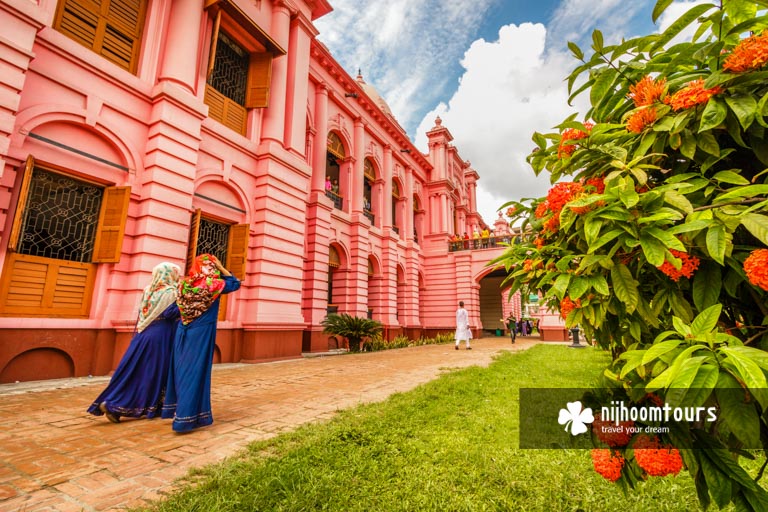
Visitors at Pink Palace in Old Dhaka. ©Photo Credit: Raw Hasan.
Ahsan Manzil Ticket
Ahsan Manzil tickets are available at the site ticket counter 30 minutes before the visiting hours. It is also possible to purchase Ahsan Manzil tickets online before going there.
Ahsan Manzil Ticket Price
The ticket price of Ahsan Manzil varies depending on the nationalities of the visitors as follows.
Bangladeshi Visitors
Ahsan Manzil ticket price for local Bangladeshi visitors is 50 BDT (TK) per person for adults and 20 BDT per person for children.
Foreigners from the SAARC Countries
Ahsan Manzil ticket price for visitors from the South Asian Association for Regional Cooperation (SAARC) countries, e.g., India, Pakistan, Nepal, Bhutan, Sri Lanka, Maldives, and Afghanistan, is 300 BDT per person for adults.
Foreigners from other countries
Ahsan Manzil ticket price for foreigners from other countries outside SAARC is 500 BDT per person for adults.
▲ Back to the Table of Contents
Ahsan Manzil Online Ticket
Ahsan Manzil introduced an online ticketing system during the Covid-19 pandemic, which is still active. You can purchase Ahsan Manzil Online Tickets from their official website on the same day of visiting the site.
Ahsan Manzil Online Ticket Price
The price of the Ahsan Manzil Online Ticket is the same as the regular ticket. However, a 4% online payment processing charge is added to the ticket price.
Ahsan Manzil Online Ticket Accepted Payment Methods
You can use any Visa, MasterCard, Amex international and local debit and credit cards, local online banking systems, and mobile financial systems like bKash, Rocket, MCash to purchase Ahsan Manzil online tickets.
Ahsan Manzil Online Ticket Availability
You can purchase Ahsan Manzil online tickets during the following time only for the same day:
Saturday-Wednesday: 10.30 am – 4.00 pm.
Friday: 3.00 pm – 6.30 pm.
Ahsan Manzil Online Ticket Tips
A limited number of tickets for Ahsan Manzil are sold through their online ticketing system. Also, using the site is highly frustrating. On weekends (Fridays and Saturdays), you may find all the tickets are sold out—nothing to worry about. You can still purchase tickets from the ticket counter at the site.
▲ Back to the Table of Contents
Ahsan Manzil Contact No
- Phone No: +880-2-58315954 (Landline – During the office hours only)
- Email: info@ahsanmanzil.org.bd
▲ Back to the Table of Contents
Frequently Asked Questions
What are the visiting hours of Ahsan Manzil?
10.30 AM-5.30 PM on Saturday-Wednesday, and 3.00 PM-7.00 PM on Friday during Summer (April-September). 9.30 AM-4.30 PM on Saturday-Wednesday, and 2.30 PM-7.00 PM on Friday during Winter (October-March).
What is the off day of Ahsan Manzil?
Thursdays are the off days of Ahsan Manzil. During the holy month of Ramadan, it is Thursdays & Fridays. Ahsan Manzil will also remain closed on public holidays, during the Eid days, and the previous day of the Eid days.
What is the ticket price of Ahsan Manzil?
40 BDT for Bangladeshi adults, 20 BDT for Bangladeshi children, 300 BDT for foreigners from SAARC countries, and 500 BDT for foreigners from other countries.
Can I buy tickets for Ahsan Manzil online?
Yes, buying tickets for Ahsan Manzil online on the same day is possible.
▲ Back to the Table of Contents
Visiting Ahsan Manzil
Planning to visit Ahsan Manzil? We can help organize a memorable holiday in Dhaka for you to experience the best of it, including a visit to Ahsan Manzil. We are an award-winning local tour operator in Bangladesh specializing in organizing tours and holidays in Bangladesh for Western travellers, with 420+ reviews on TripAdvisor with an average rating of 4.9 out of 5. Check out our Dhaka City Tour for a day tour in Dhaka with comfort and safety. Contact us now for your memorable Dhaka holiday!
Check out our 1-28 days Bangladesh tour packages and 3-8 days Sundarban Tour Packages in Bangladesh to visit Bangladesh with comfort.
▲ Back to the Table of Contents
Reference:
- Ahsan Manzil O Dhakar Nawab: Oitihasik Ruprekha – Dr. Muhammad Alamgir
▲ Back to the Table of Contents
Share This
Share this article with friends by clicking any button below. Let them know about amazing Bangladesh, which is one of the least traveled destinations in the world. Share now!
[scriptless]

